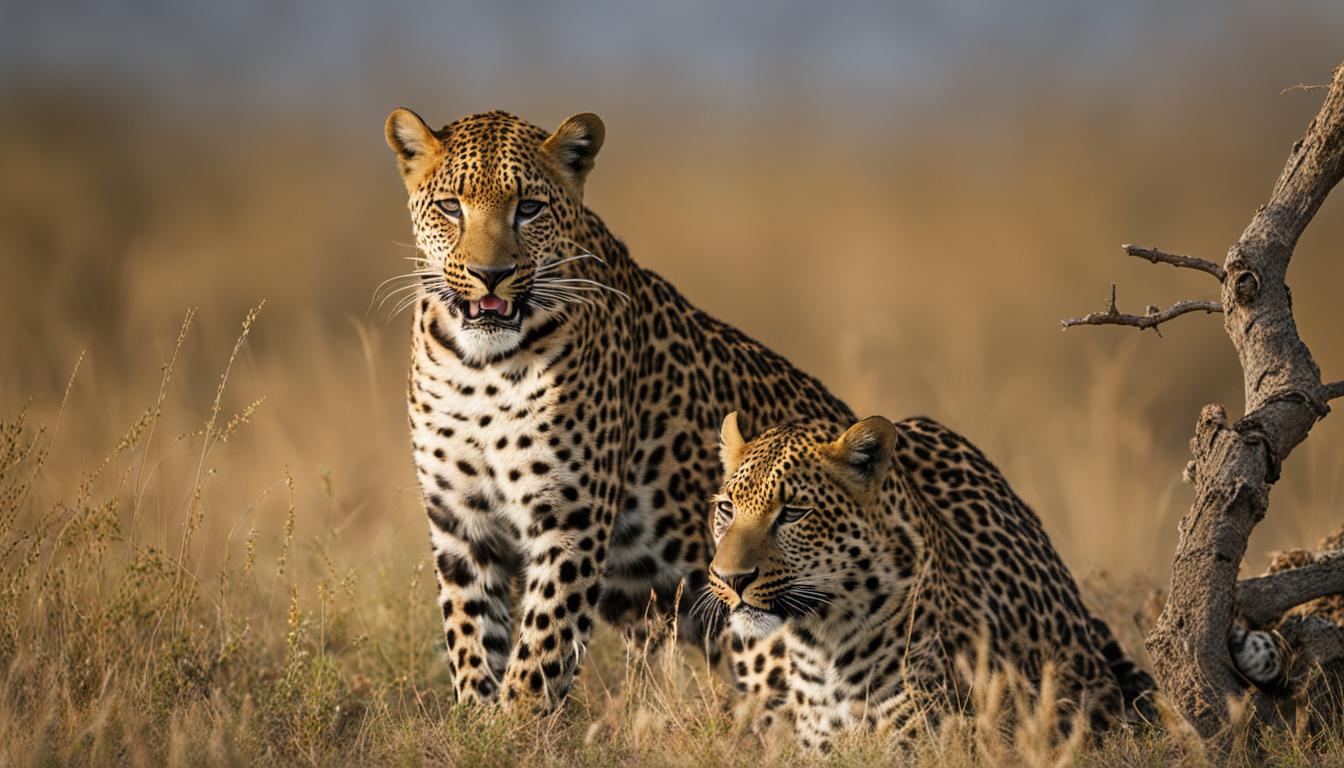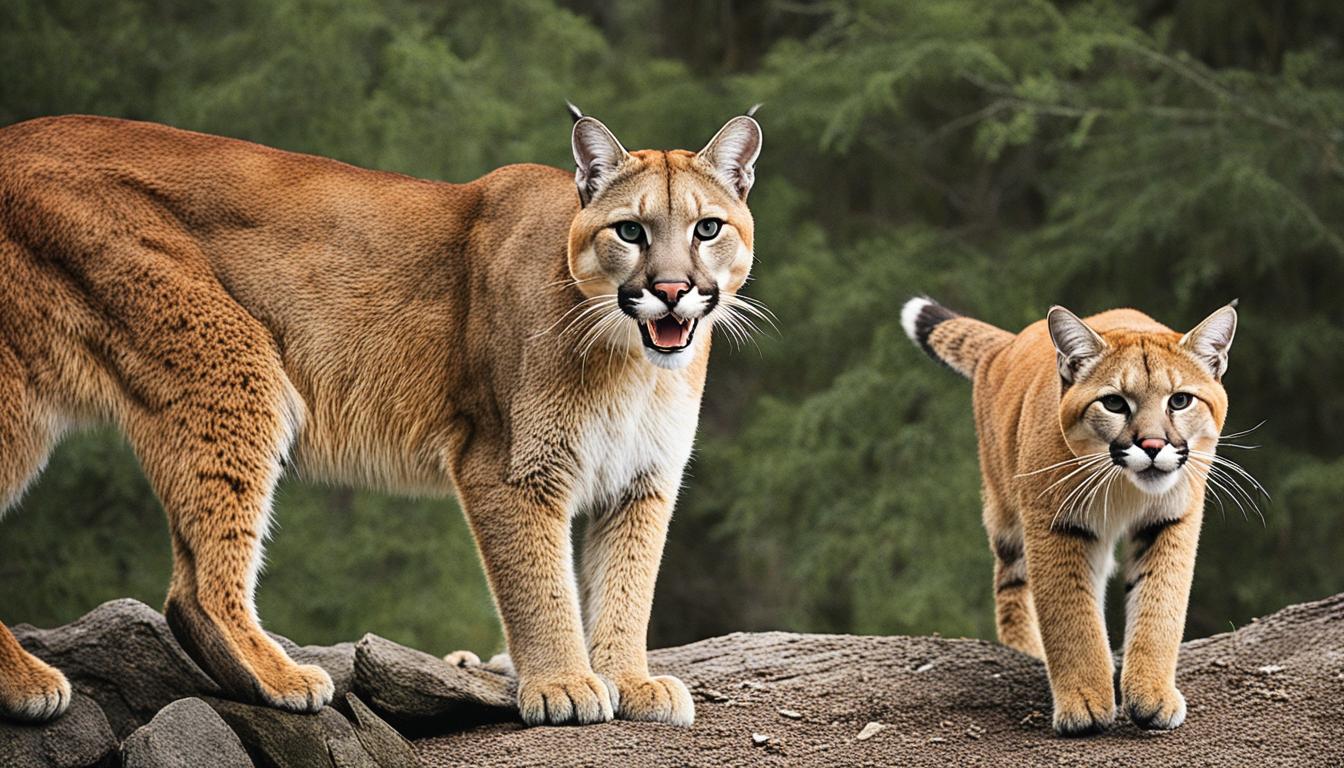Leopards, known for their solitary nature, have been found to exhibit a surprising degree of social complexity. Research using camera traps has revealed that leopard social units can consist of up to five individuals. Both same-sex and opposite-sex interactions occur within these units for territorial and reproductive purposes. Communication cues, such as scent marking, play a crucial role in these social interactions. Central individuals within the social units are important for maintaining social cohesion and stability. Understanding leopard behavior and social structure is essential for the management and conservation of leopard populations.
Importance of social behavior in leopard population management
The social behavior of leopards plays a crucial role in the management and conservation of their populations. Understanding the complexities of leopard social structures and behavior is essential for effective population regulation and maintaining population stability.
Research has shown that the removal of central individuals within leopard social units has a significant impact on social cohesion and group stability. These central individuals, often occupying higher positions in the dominance hierarchy, have a strong influence on the behavior and interactions of other group members. Their presence is vital for the functioning of the group and maintaining population dynamics.
Conservation efforts must consider the importance of social behavior in leopard populations. By protecting the social organization of leopards, including the presence of central individuals, we can ensure the stability and sustainability of their populations. This involves considering the impact of human activities, such as legal harvest or preemptive removal, on social cohesion and population demography.
| Leopard Social Behavior | Population Regulation | Conservation of Leopard Populations |
|---|---|---|
| Complex social structures | Role of central individuals | Social organization protection |
| Impact on social cohesion | Influence on group behavior | Consideration of human activities |
| Group stability and dynamics | Population demography | Sustainability of leopard populations |
The intricate social behaviors exhibited by leopards highlight the need for further research and understanding of their social structures. This knowledge can not only aid in the conservation and management of leopard populations but also provide insights into the social behaviors of other seemingly solitary species. By acknowledging the importance of social behavior, we can develop more effective strategies to protect and preserve these fascinating animals for future generations.
Factors influencing leopard social organization
| Factors | Description |
|---|---|
| Territorial Behavior | Leopard territorial behavior plays a significant role in their social organization. They mark their territories through scent marking, using glands located on their face, paws, and anal region. This marking serves as a communication cue to other leopards, indicating the presence of a dominant individual and defining the boundaries of the territory. |
| Communication Cues | Leopards communicate with each other through various cues, including vocalizations, body postures, and scent marking. Scent marking is particularly important for maintaining territorial boundaries and communicating reproductive status. By depositing their scent, leopards can establish their presence and assert their dominance within their social units and neighboring territories. |
| Group Dynamics | The dynamics within leopard social units and interactions with individuals outside the group help shape their social organization. Leopards engage in both cooperative and competitive behaviors within their social units, such as grooming and playing, which strengthen social bonds. Interactions with neighboring leopards, especially those of the same sex, can lead to territorial disputes and spatial segregation. |
These factors work together to influence leopard social organization. Territorial behavior and communication cues define the boundaries and structure of social units, while group dynamics shape the relationships and interactions within and between these units.
The scent marking of leopards serves as a vital communication tool, allowing them to establish and defend their territories. By scent marking, leopards can assert their dominance, maintain social cohesion, and convey important information.
Temporal segregation, where males and females co-occur during specific periods for mating, is another factor influencing leopard social organization. This allows for reproductive opportunities while minimizing potential conflicts between individuals.
Understanding these factors and their influence on leopard social organization is essential for comprehending the complexities of their social behavior. By studying leopard territorial behavior, communication cues, and group dynamics, researchers can gain insights into the social structures and dynamics of this fascinating species.
Group Stability and the Role of Central Individuals
In leopard social units, the presence of central individuals plays a crucial role in maintaining group stability and social cohesion. These central individuals, often occupying higher positions in the dominance hierarchy, have a significant influence over the behavior and interactions of other group members. Through their interactions both within and outside the social unit, they contribute to the functioning and structure of the group.
Central individuals act as key mediators in resolving conflicts and ensuring social order within the group. Their presence helps in maintaining harmonious relationships among group members, reducing the likelihood of disruptive behaviors or aggression. By asserting their dominance and regulating social interactions, these individuals contribute to the overall stability and cohesiveness of the group.
Furthermore, the removal or absence of central individuals can have negative consequences for group stability. Without their influence and guidance, the group may experience a breakdown in social order, leading to increased aggression, competition for resources, and even fragmentation of the social unit. The loss of central individuals can disrupt social cohesion and hinder the group’s ability to effectively coordinate activities such as hunting, mating, and territorial defense.
Role of Central Individuals in Group Dynamics
The central individuals in leopard social units not only maintain group stability but also play an important role in group dynamics. They facilitate communication and coordination among group members, fostering cooperation and mutual support. Central individuals often initiate and lead group activities, such as scent marking, vocalizations, and hunting expeditions.
| Role of Central Individuals | Examples |
|---|---|
| Facilitating Communication | Initiating vocalizations that signal group members to gather or disperse. |
| Coordinating Hunting | Leading group members in cooperative hunting strategies, ensuring successful prey capture. |
| Maintaining Territorial Boundaries | Scent marking and patrolling to protect the group’s territory from intruders. |
The presence of central individuals within leopard social units is essential for maintaining group stability, coordinating group activities, and ensuring the overall cohesiveness of the group. Their role in maintaining social order and facilitating communication highlights the significance of their presence in the social structure of leopards.
Implications for Leopard Population Conservation
The understanding of leopard social behavior has important implications for their conservation. By recognizing the complexity of social structures and the role of social behavior in population regulation, conservation efforts can be more effective. It is crucial to protect the social organization of leopards, including the presence of central individuals, to maintain population stability and ensure the long-term survival of the species.
Managing social behavior is key to effective conservation strategies. Human activities, such as legal harvest or preemptive removal, should consider the impact on social cohesion and population demography. The removal of central individuals can disrupt group stability and negatively impact the overall population.
To illustrate the importance of managing leopard social behavior, consider the following table:
| Population Management Approach | Impact on Social Cohesion | Impact on Population Demography |
|---|---|---|
| Protecting Central Individuals | Increases social cohesion within groups | Maintains stable population dynamics |
| Removing Central Individuals | Disrupts social cohesion | Results in population instability |
| Conservation Education | Raises awareness and fosters coexistence | Promotes sustainable population growth |
As shown in the table, protecting central individuals fosters social cohesion and maintains stable population dynamics. Conversely, removing central individuals disrupts social cohesion and results in population instability. Conservation education plays a crucial role in raising awareness and promoting coexistence, ultimately contributing to the sustainable growth of leopard populations.
Understanding and managing leopard social behavior is a key component of successful leopard population conservation. By implementing strategies that consider social dynamics and protect central individuals, we can ensure the long-term survival and well-being of these magnificent animals.
Conclusion
Leopards, once thought to be solitary creatures, have revealed a hidden complexity in their social behavior. Through the use of camera traps, researchers have discovered that leopard social units can consist of multiple individuals, engaging in various interactions for territorial and reproductive purposes. This newfound understanding of leopard social hierarchy challenges previous assumptions and highlights the need for comprehensive conservation management.
Social behavior and the presence of central individuals within leopard groups play a crucial role in maintaining social cohesion and group stability. These central individuals, often occupying higher positions in the dominance hierarchy, influence the behavior and interactions of other group members. Protecting their presence is vital to ensure the overall well-being and stability of the group.
Recognizing the complexities of leopard social behavior has important implications for their conservation. Effective conservation strategies must consider the impact of human activities on social cohesion and population demography. By understanding and protecting the intricate social structures of leopards, we can develop better management practices that promote the long-term survival of these magnificent animals, as well as other species that may exhibit similar social complexities.
Do leopard and cheetah groups follow similar patterns in establishing social hierarchies?
Leopard and cheetah groups both have intricate processes for establishing social hierarchies. However, the establishing social hierarchies in cheetah groups tend to be more fluid and less rigid compared to leopards. Cheetahs often form coalitions with other males, while leopards are typically solitary creatures.
FAQ
How are social hierarchies established in leopard groups?
Social hierarchies in leopard groups are established through interactions and dominance relationships among group members. Central individuals often hold higher positions in the dominance hierarchy and have a significant influence on the behavior and interactions of other group members.
What is the importance of social behavior in leopard population management?
Social behavior plays a critical role in regulating population dynamics and maintaining stability within leopard populations. Understanding social behavior is essential for effective management and conservation efforts to ensure the long-term viability of leopard populations.
What factors influence leopard social organization?
Leopard social organization is influenced by various factors, including territorial behavior, communication cues such as scent marking, group dynamics, and interactions within and outside the social units. These factors shape the social structure and organization of leopards.
What is the role of central individuals in group stability?
Central individuals within leopard social units play a fundamental role in maintaining group stability and social cohesion. They interact both within and outside the social unit and are crucial for the functioning of the group. Their removal can have negative effects on social cohesion and impact the stability of the group.
What are the implications for leopard population conservation?
The understanding of leopard social behavior has important implications for the conservation of their populations. Recognizing the complexity of social structures and the role of social behavior in population regulation is key for effective conservation strategies. Protecting the social organization of leopards, including the presence of central individuals, is vital to maintaining population stability.
What is the significance of leopard social hierarchy in conservation management?
The establishment and maintenance of leopard social hierarchy are crucial aspects of conservation management. By considering the complexities of leopard social hierarchy, conservationists can develop better strategies to protect and manage leopard populations, ensuring their long-term survival.









